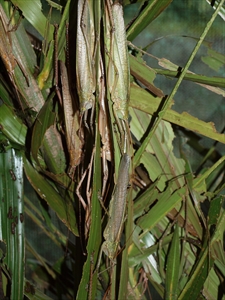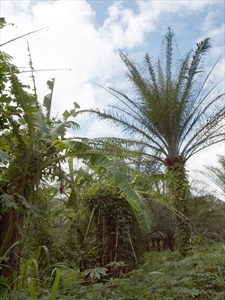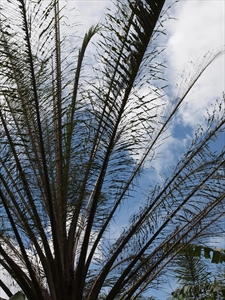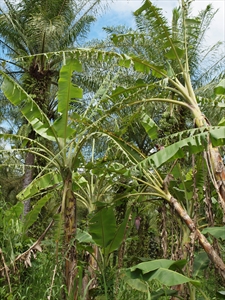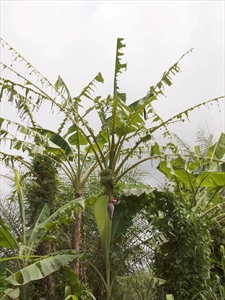Coconut treehopper, long-horned grasshopper. They are also known as katydids or bush crickets.
Pacific Pests, Pathogens, Weeds & Pesticides - Online edition
Pacific Pests, Pathogens, Weeds & Pesticides
Coconut sexava treehopper (246)
Sexava is the name given to a number of species of long-horned grasshoppers belonging to several genera: Segestes, Segestidea and Sexava. Those recorded in Papua New Guinea on coconuts are: Sexava nubila, Segestes decoratus, Segestidia leefmansi, Segestidia rufipalpis, Segestidia uniformis, Segestidia defoliara, Segestidia novaeguineae), and oil palm: Segestes decoratus, Segestidia defoliaria, Segestidea novaeguineae. Sexava species are recorded from Solomon Islands.
The species are recorded from Indonesia, Papua New Guinea, and Solomon Islands.
Several species of palms are attacked, including betel nut, coconut, nipa, oil palm and sago; other plants attacked are banana, Heliconia, Pandanus, Ravenala (traveller's palm), and sugarcane.
On coconuts, two types of outbreak are reported: first, localised outbreaks in areas of overgrown coconuts where rainfall is evenly distributed (Photo 1); secondly, widespread outbreaks where rains follow droughts and eggs hatch at the same time.
The insects feed at night and descend to the ground during the day or shelter on the undersides of leaves or at the base of leaves in the crown (Photos 2-4).
Eggs are slender, slightly curved, about 10 mm long, mostly laid in the soil, but also on the butts of fronds or on plants growing on the stems of palms. After about 8 weeks, the eggs hatch. The nymphs are green or brown adults depending on the species, and moult six times over about 3 weeks. Adults live about 110 days. From egg to adult is 30-40 weeks. In some species, males have either long or short wings. In general, flight is poor, but they can run and jump.
The nymphs and adults occasionally cause severe damage to coconuts and oil palm (Photos 4-6) and bananas (Photos 7&8). The leaves are eaten to the midribs and the insects attack the flowers and young fruits. The damage results in loss of fruits as palms lack the nutrients for their development. If coconuts are defoliated to 70% it takes about 2 years before the palms return to previous yields. Yields begin to be affected when 40% defoliation occurs.
Look for grasshopper-like insects 50-60 mm long (not including the antennae). Look for the antennae that are much longer than the body, a feature distinguishing the long-horned from the short-horned grasshoppers and locusts. Look for the ovipositor of the female which is like a sword with a curved blade.
NATURAL ENEMIES
Egg, nymph and adult parasitoids have been recorded from long-horned grasshoppers. However, egg parasites are thought to be the most reliable as a majority of sexava eggs are laid in the soil. Only the parasitoid, Stichotrema dallatorreanum, is considered to be important; this insect is unusual in that the 1st instar male larvae parasitise ants and the female parasitises sexava species. The sexava attacked in Papua New Guinea are Sexava nubila, Sefestes decoratus and Segestia novaeguineae. The parasitoid reduces the number of eggs laid by female sexava, and their lifespan.
BIOLOCIAL CONTROL
As cultural and chemical control measures have proved to be impractical or uneconomical, the research in Papua New Guinea in the last 70 years has been to improve biological control, including the use of mycoinsecticides, but none are available commercially.
CULTURAL CONTROL
Two methods have been suggested, but neither appears practical or economical:
- Place sticky bands of gum resin (Tanglefoot) around the trunks of coconuts.
- Rake and/or hoe the soil beneath palms to expose eggs.
CHEMICAL CONTROL
Insecticides are not appropriate for the management of the long-horned grasshopper as they will delay the return of biological control. The spraying of broad-spectrum insecticides is unacceptable, and trunk injections use organophosphates, many of which have been withdrawn from use.
AUTHOR Grahame Jackson
Information from Young GR (2001) A review of sexava research and control methods in Papua New Guinea. In: Proceedings of the sixth workshop for the tropical agricultural entomologists. Technical Bulletin No. 288, 1998. Darwin. Photos 1-7 Richard Markham, ACIAR, Canberra.
Produced with support from the Australian Centre for International Agricultural Research under project PC/2010/090: Strengthening integrated crop management research in the Pacific Islands in support of sustainable intensification of high-value crop production, implemented by the University of Queensland and the Secretariat of the Pacific Community.



